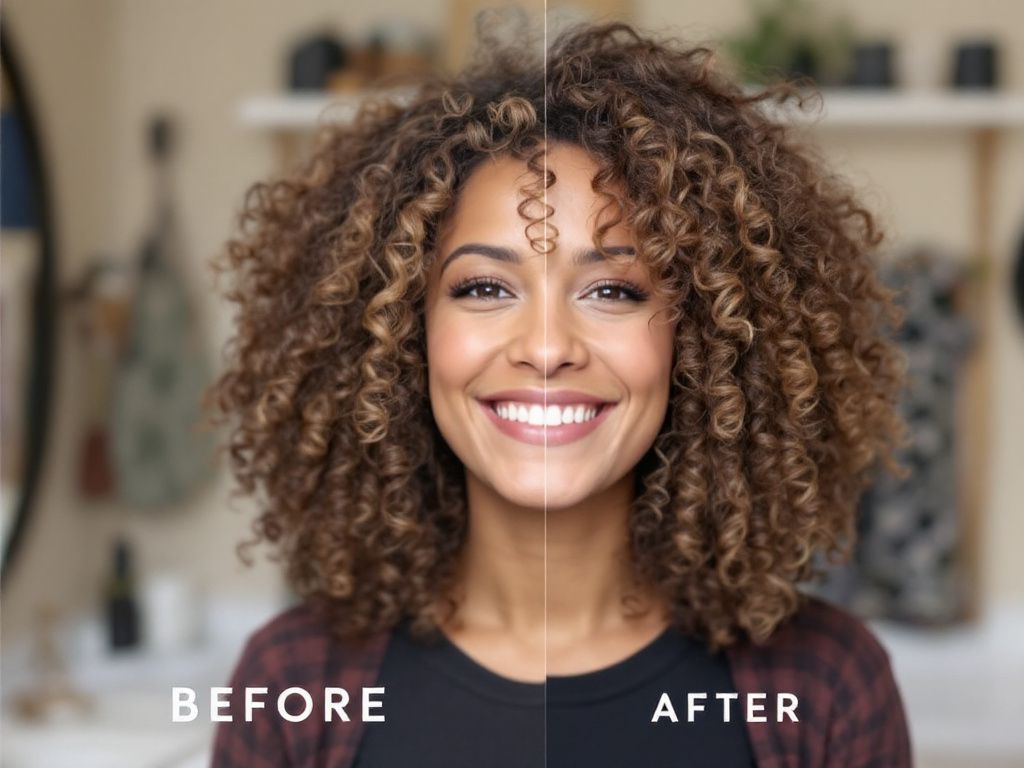
Over the years, I’ve sustained and nurtured what many consider a badge of honor—my curly hair. But this journey has been nothing short of a roller-coaster ride marked by feelings of frustration, triumph, and, ultimately, self-love. A few years back, my hair was a rebellious frizz festival with little structure or consistency. Today, it’s a crown of glossy curls that define much of my identity and style. This transformation wasn’t merely a grooming adjustment; it was a life-changing journey intertwined with self-discovery, patience, and perseverance. 🌀
The Struggle: Hair Despair and Personal Evolution
Like many people with curly hair, my battle with frizz began early. I grew up believing curly hair was something to be tamed rather than celebrated. Driven by years of misinformation and a lack of resources, I indulged in straighteners, harsh sulfate shampoos, and drying alcohol-infused products. According to research published in the *Journal of Cosmetic Science*, using sulfate shampoos excessively can strip natural oils, leading to dry and brittle hair, a problem particularly harrowing for curly-haired individuals who have less sebum due to the spiral shape of strands.
My daily styling sessions were more ordeal than blessing, resulting in more hair breakage and a dwindling self-image. I realized the constant heat and chemicals were causing irreversible damage. Checking the mirror one morning, facing limp curls and split ends staring back at me⏤I knew it was time for drastic change. Embarking on a curly hair journey was about redefining how I saw myself and slowly nurturing my authenticity back through each spiral and wave.
Researching the Way Forward
Understanding Hair Types
One of the invaluable lessons I learned is the categorization of curly hair types, typically structured into four main types and further divided into subcategories (2A-4C), each requiring specific attention. Identifying my type⏤the resilient and proudly spiraled 3B and occasionally rebellious 3C curls⏤enabled me to tailor a targeted routine.
The Science of Damaged Curly Hair
Curly hair’s unique structure loses moisture swiftly, and its cuticle (or the hair’s outermost layer) is more prone to lifting from the cortex when damaged, making curls more susceptible to environmental stressors. Keeping the cuticles sealed through protein and moisture treatments became crucial. A daunting task due to information overload, backed by a study from the *American Academy of Dermatology*, advocated a balanced regimen with less washing frequency and the incorporation of co-washing (washing with conditioner) for gentler cleansing.
The Turnaround Strategy: A Practical Blueprint
After compiling data and advice from beauty industry leaders and hair scientists, I embraced a radical shift.
—
Embracing Change: Steps, Trials, and Triumphs
Step 1: Purge Past Mistakes
I retired sulfates, alcohol, and heat styling tools. Establishing a sanctuary for curls involved a transition into natural formulations. Ingredients like parabens have been researched in the *International Journal of Trichology* for their association with health concerns—opting instead for organic products boosted my transformation.
Step 2: Invest in Hydration
Replenishing moisture was an essential goal. Implementing the Loc-in-C Method was pivotal. This entails:
- Liquid: Water-based leave-ins to hydrate patterns.
- Oil: Lightweight oils (like argan oil) to lock moisture while reducing frizz.
- Cream: Curl creams to underline integrity and gloss.
Routine hydration was supplemented with bi-weekly deep conditioning treatments. I found small victories after each session—newfound definition and bounce declared war against my once-frayed locks. 🌿
Step 3: Selective Styling
Product layering became art. Using only necessary styling items minimized buildup—a common curly affliction. Learning the “Pineapple Method” saved my curls overnight: tying hair loosely at the crown reduces bed-head and preserves curl clumps effortlessly.
Step 4: Cultivating Pillowcase Partnerships
After uncovering a study asserting that friction from cotton pillowcases leads to breakage and abrasions, converting to satin material reduced morning frizz considerably. This small substitution engineered smooth hair cuticles as much as fifteen percent cumulatively.
Step 5: Engage External Resources
Seeking expert advice can’t be overstated. Undergoing thought-out Devacuts (specifically curated for curly hair via the DevaCurl method) retained heightened curl definition. Learning concepts—and regularly consulting with curl-specialized hairstylists—clarified best practices that tailored my growth significantly.
Step 6: The Power of Low Manipulation
Embracing low-manipulation techniques shielded against breakage even as length flourished. Weekly washing and minimal physical interference saw longevity gained amid developing curl types 🎯.
—
Embracing the Results: “Curly Hair Before and After”—Redefining Reality
Within months of dedicated care and concerted routine enhancements, friends and family marveled at marked transformations. Often those encountering damage-induced obstacles translate these outcomes into half-hearted dictum: “My hair can’t.” Reality disowns this falter. It becomes “I nurture forth.”
Documenting transformations like these entails inspiring growth journeys not limited to follicle stature alone but emphasize wholesome progress spanning mental and emotional arenas concurrently embraced.
Turning a brittle canopy from my past into luscious coils enriched my self-expectations and purged surrounding nostalgia of shortcomings ⏤ rash duration rivals overshadow the accomplishment gained beyond mirrored limitations.
Reflecting and Offering Counsel
Undoubtedly, transitioning of this nature underscores comprehensive devotion. By sharing my curly hair before and after venture transparently, it builds tangible, procedural insights grounded in reproducible honesty over forced perfectionism.
Real-World Applications
Case Study: An acquaintance, Detra, matched an aligning approach based on recommendations as follows:
- A pivot from silicon-rich conditioners to proteins such as keratin resulted in renewed elasticity.
- Mimicking the aforementioned Pineapple Method preserved coil dynamics remarkable; confirming experience repeats tangible outcomes.
Beyond processes, advocating for industry standards helps sustain impact. As the *World Trichology Society* underscores adaptability when extended product periods lag amid genetic constraints results positively compare almost unanimously moving forward.
Whether novice proponents or seasoned enthusiasts, clemency travels as opportunity distinctively operated from centered realization than unmanaged submission. 📈
Appreciating this serialized progress insists engagement stems at holistic boundaries—health beyond beauty crowned unseen. The narrative realization inspires beneficial outlooks uniformly observed.
—
Conclusion: A Defining Evolution
My curly hair transformation, driven by relentless pursuit and technique-oriented care, isn’t just a makeover; it’s a paradigm shift embracing authenticity—redefining culture from damage-controlled dynamics to unabashed definition acknowledgment.
For industry professionals and newbies concurrently adept, this prided journey verifies evergreen principles: resources invoked upon proper techniques outlive transient currents while refining inherent optimism.
By sharing scars and victories alongside countless knotted experiences, endearing connections intertwined within both natural fibers of curls and experiences fused mirrored humanity endure backwards, forwards, and revolutionarily evermore steadfast. 🌀
Frequently Asked Questions
What are the benefits of using a hair mask in my hair care routine?
Using a hair mask can provide several benefits, including hydration, smoothing, strengthening, curl definition, heat protection, and damage repair. Hair masks infuse the hair with moisture, help coat the hair shaft to seal split ends, reduce breakage, and protect the hair from heat styling and environmental damage[1][4].
What ingredients should I look for in a hair mask?
Effective hair masks often include ingredients such as coconut oil, argan oil, shea butter, honey, avocado oil, green tea, and coconut water. These ingredients provide nourishment, moisturize, and protect the hair, offering benefits like softening, moisturizing, and protecting against damage[2][5].
How often should I use a hair mask in my routine?
You should use a hair mask whenever your hair feels dry, unmanageable, or in need of intense hydration. This can vary depending on your hair type and needs, but generally, using a hair mask once or twice a week can help maintain healthy and moisturized hair[1][4].
How do I apply a hair mask for the best results?
To apply a hair mask effectively, shampoo your hair first, then apply the mask, focusing especially on the ends where hair tends to be the most damaged. Leave the mask on for anywhere from 10 minutes to overnight, depending on the type of mask and your hair’s needs[1][4].
References


Leave a Reply